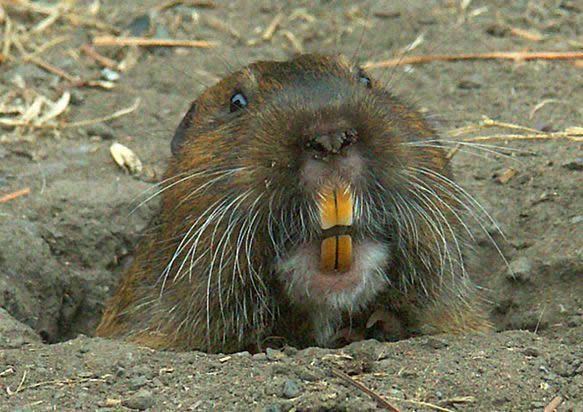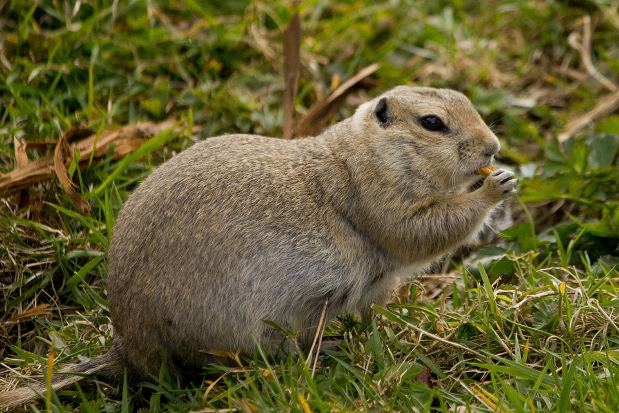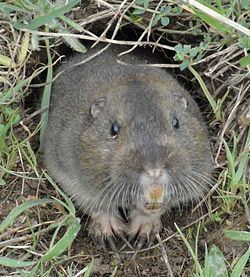Scientific name Geomyidae Rank Family | Phylum Chordata Higher classification Myomorpha | |
 | ||
Lower classifications | ||
Pocket gophers
Pocket gophers, commonly referred to as gophers, are burrowing rodents of the family Geomyidae. About 35 species of gophers live in Central and North America. They are commonly known for their extensive tunneling activities. Gophers are endemic to North and Central America.
Contents
- Pocket gophers
- Pocket gopher control
- Description
- Behavior
- Control
- Classification
- In popular culture
- References

The name "pocket gopher" on its own may be used to refer to any of a number of genera within the family. These are the "true" gophers; however several ground squirrels in the distantly related family Sciuridae are often called gophers, as well.

Pocket gopher control
Description

Gophers weigh around 0.5 lb (230 g), and are about 6–8 in (150–200 mm) long in body length, with a tail 1–2 in (25–51 mm) long. A few species reach weights approaching 1 kg (2.2 lb). Within any species, the males are larger than the females and can be nearly double their weight.

Their lifespans are normally one to three years assuming no diseases or predation. The maximum lifespan for the pocket gopher is about five years. Some gophers, such as those in the genus Geomys, have lifespans that have been documented as up to seven years in the wild.

Most gophers have brown fur that often closely matches the color of the soil in which they live. Their most characteristic features are their large cheek pouches, from which the word "pocket" in their name derives. These pouches are fur-lined, can be turned inside out, and extend from the side of the mouth well back onto the shoulders. Gophers have small eyes and a short, hairy tail, which they use to feel around tunnels when they walk backwards.
Pocket gophers have been found to often carry external parasites. Common predators of the gopher include weasels, snakes, and hawks.
Behavior
All pocket gophers create a network of tunnel systems that provide protection and a means of collecting food. They are larder hoarders, and their cheek pouches are used for transporting food back to their burrows. Gophers can collect large hoards. Unlike ground squirrels, gophers do not live in large communities and seldom find themselves above ground.
The entrances can be identified by small piles of loose soil covering the opening. Their burrows can be found in many areas where the soil is softer and easily tunneled. They often appear in vegetable gardens, lawns, or farms, as gophers like moist soil (see Soil biomantle). This has led to their frequent treatment as pests.
Gophers eat plant roots, shrubs, and other vegetables such as carrots, lettuce, radishes, and any other vegetables with juice. Some species are considered agricultural pests. The resulting destruction of plant life then leaves the area a stretch of denuded soil. At the same time, the soil disturbance created by turning it over can lead to the establishment of early successional communities of r-selected and other ruderal plant species. The stashing and subsequent decomposition of plant material in the gophers' larder can produce deep fertilization of the soil.
Pocket gophers are solitary outside of the breeding season, aggressively maintaining territories that vary in size depending on the resources available. Males and females may share some burrows and nesting chambers if their territories border each other, but in general, each pocket gopher inhabits its own individual tunnel system. Although they attempt to flee when threatened, they may attack other animals, including cats and humans, and can inflict serious bites with their long, sharp teeth.
Depending on the species and local conditions, pocket gophers may have a specific annual breeding season, or may breed repeatedly through the year. Each litter typically consists of two to five young, although this may be much higher in some species. The young are born blind and helpless, and are weaned at around 40 days.
Control
Geomys and Thomomys species are classed as "prohibited new organisms" under New Zealand's Hazardous Substances and New Organisms Act 1996 preventing them from being imported into the country.
Classification
Much debate exists among taxonomists about which races of pocket gopher should be recognised as full species, and the following list cannot be regarded as definitive.
Some sources also list a genus Hypogeomys, with one species, but this genus name is normally used for the Malagasy giant rat, which belongs to the family Nesomyidae.
In popular culture
Minnesota is nicknamed the "Gopher State", and the University of Minnesota's athletics teams are collectively known as the Golden Gophers, led by mascot Goldy Gopher. Internet Gopher protocol was created at the University of Minnesota. Gainer the Gopher is the mascot of the Saskatchewan Roughriders in the Canadian Football League. A gopher also plays a key role in the film Caddyshack. The mascot of the Go programming language is the Go Gopher. Gordon the Gopher is an English puppet gopher which appeared on Children's BBC (CBBC) between 1985 and 1987. Gophers! was a British children's programme that ran on Channel 4 between 1988 and 1990.
